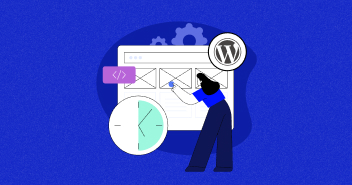
If you have been in the online business, you must have heard of a Distributed Denial-of-Service (DDoS) attack. DDoS is not new; it came up in the early 90s, and hackers have used it to put web services out of order by sending loads of requests to the victim’s server.
If your business relies on your website, you can’t risk falling prey to hackers; so you must protect it against DDoS attacks. This blog will share the best practices for doing so and will share all the protection measures. Keep reading to find out more!
Before we jump into learning how to protect your WordPress site from DDoS attacks, let’s know more about DDoS attacks and their working.
What Are DDoS Attacks?
DDoS follows the approach of an attacker sending traffic (or “requests”) through compromised networks and computers to a single target, making the targeted system so busy that it stops responding to any other requests coming from legitimate users.
Attackers use these tactics to target and blackmail specific sites and demand ransom. Insecure devices and users following bad digital practices are most vulnerable to DDoS attacks.
These attacks are quite difficult to prevent because malicious traffic comes from various sources. However, by following the digital best practices and opting for secure WordPress hosting, anyone can safeguard their websites against these attacks.
For personalized hosting solutions, explore our web hosting pricing calculator. Discover optimal server sizes and align your hosting with security measures to fortify your website against potential threats.
How Does DDoS Work?
A target server or network receives requests from compromised systems during a DDoS attack. The requests are so frequent that the bandwidth limit of a network of resources of a server maxes out. This slows down the server response, and in severe cases, it is rendered useless.
Website Under DDoS Attack? Try out Cloudflare Enterprise Add-on!
Cloudflare Enterprise mitigates DDoS attacks while ensuring maximum performance and security of your website.
Types of DDoS Attacks
DDoS attacks can be categorized into two types:
- Volumetric Attacks
- Application Layer Attacks
Each of these attacks may come up in the different layers of the OSI (Open Systems Interconnection) model.

The OSI model is a conceptual framework that describes a networking system’s functions. It divides the networking system into seven layers that are as follows:
- Physical Layer
- Data Link Layer
- Network Layer
- Transport Layer
- Session Layer
- Presentation Layer
- Application Layer
Networking engineers use these layers’ to help discover the problems within their networks.
Let’s learn more about these DDoS attack types:
Volumetric Attacks
Volumetric attacks mainly target the Network Layer and the Transport Layer of the OSI model. This attack targets a site or network by bombarding it with traffic and requests from botnets and infected zombie systems.
They utilize infected systems to generate a high traffic bandwidth. The systems are distributed geographically with bandwidths exceeding well over 10 TBPS, and these attacks are becoming even more sophisticated.
Protocol Attacks
Protocol attacks target the load balancers and firewalls to exhaust the server resources. They flood the network infrastructures with malicious connection requests.
Attacks like connection floods, TCP connection exhaustion, SYN floods, and ICMP/UDP floods are some of the attacks that fall under protocol attacks.
Application Layer Attacks
Application layer DDoS attacks are also known as Layer-7 DDoS attacks. These attacks usually target the vulnerabilities in web applications by sending traffic to particular sections of a website.
When these attacks infect a web app, it increases bandwidth consumption. However, these attacks don’t bring a website down but instead slow it down by a great deal.
Unlike volumetric attacks, application layer attacks are much harder to detect, as the traffic seems like real traffic driven by humans. Usually, they utilize HTTP, DNS, and SMTP requests.
Let’s take a look at some of the major Application layer DDoS attacks:
1. HTTP Flood DDoS Attack
An HTTP flood attack uses the fake HTTP Get or POST requests and makes them look legit to attack a web application. These attacks are quite difficult to be identified because they utilize the standard URL requests.
HTTP flood attack tries to overload the targeted server with HTTP requests, ultimately making the server unable to respond to the incoming traffic, giving real users a denial of service.
2. Asymmetric Attacks
In asymmetric attacks, the Application Layer receives high-workload requests that consume server resources such as RAM and CPU.
3. Repeated One-Shot Attacks
These attacks target both Application and Network layers by sending high-workload requests on applications combined with TCP sessions.
4. Application Exploit Attacks
The Application Exploit attacks target application vulnerabilities that take over or manipulate an application to cause a server or OS malfunction. The most common are SQL injection, cookie poisoning, and cross-site scripting.
Target of the DDoS Attacks
DDoS attacks aim to block online services, websites, and applications by flooding them with malicious traffic. The goal is to make the target unavailable to its users and stop the service. DDoS attacks target large ranges of resources people depend on daily (financial services, medical information, media, education systems, and online shopping).
But why are hackers launching DDoS attacks? The most common reasons are:
- Political or social hacktivism. Hackers aim to cause economic or social hardship
- Conquering market share. They aim to knock out competitors
- Extortion or ransom. This type of attack is also known as Ransom DDoS. A group of criminals threatens companies with a DDoS to obtain cash. Often, these cybercriminals launch a brute force attack to demonstrate the ability to cause disruption and increase the likelihood of extortion.
Even enormous websites can fall prey to DDoS attacks. A recent example of a giant DDoS attack was in Ukraine, which targeted multiple websites.
JUST IN – DDoS attack: Multiple websites in #Ukraine are unreachable, including the Ministry of Defence, the Armed Forces, Privatbank, and Oschadbank, the Ukrainian cybersecurity center says.
— Disclose.tv (@disclosetv) February 15, 2022
Find out Whether It’s DDoS Attack or Brute Force
DDoS attacks or Brute Force are usually the same in nature as they consume your website resources, eventually making your website slower or crashing it in the extreme attack. When it comes to WordPress, there are services and plugins that can help you prevent WordPress DDoS attacks.
Install Sucuri Security just like other WordPress plugins. Go to Dashboard → Sucuri Security and check Failed Logins (see screenshot).

– Sucuri Security
How to Protect WordPress Against DDoS Attacks
We can prevent WordPress DDoS attacks via some precautionary steps and methods, and in some cases, we can completely override the minor DDoS attacks.
Also, employing some methods at the network level can help detect and block illegitimate traffic. Modern networking hardware has specialized hardware accompanied by software that can detect and filter the traffic.
Switches and Routers
Intelligent routers and switches are equipped with software capable of rate-limiting. This helps the network hardware identify bogus IPs sending illegitimate requests and block them from the further affecting system and network resources.
Smart routers and switches can easily block SYN flood attacks and “dark addresses” attacks. In most cases, you do not have access to invest in the networking hardware used by your hosting provider.
Your best bet is to go with a managed WordPress web hosting that hosts reputable data centers equipped with high-end networking hardware and provides an initial level of security against DDoS attacks.
One of the reasons Cloudways has partnered up with Cloudflare CDN and industry-leading cloud infrastructures DigitalOcean, AWS, Vultr, Google Cloud, and Linode is that their data centers are fully maintained and equipped with smart hardware running the latest software.
Cloudways provides DDoS prevention at its networking core with no additional cost to its clients.

Intrusion Prevention Systems (IPS)
Some systems detect the behavior of DDoS attacks. These are offered by many security companies out there that have developed systems that detect legitimate and illegitimate traffic patterns and filter them.
The IPS systems detect pockets of data on the network and block any malicious activity.
Scrubbing and Blackholing
All the incoming traffic is passed through a “scrubbing center” before accessing a network or application. These are maintained by companies that provide DDoS mitigation services, and therefore, they cost a lot. But, if you are a victim of large DDoS attacks affecting your business, you have no choice but to invest in a DDoS mitigation service.
Cloudways provides an initial level of security to its clients. They receive fully updated servers with application and server level firewalls that help detect the unusual behavior of traffic and halt hacking attempts at an application level.
Additional DDoS Protection Measures for WordPress
It is devastating for any WordPress-powered website owner when DDoS attacks exploit them.
Although WordPress is among the best CMS solutions and is backed by a vast community of developers, designers, and bloggers. Still, WordPress is prone to vulnerabilities, and some of the exploits are very easily utilized by DDoS attackers.
One reason is that WordPress holds a 43% share of the entire web and is an attractive target. However, a lot of the blame lies on WordPress website operators. Most users don’t even know that their website is being used as a zombie to attack another website.
Securing your website against a DDoS attack is a tough job. But, to ensure maximum safety, you can reduce the threat of DDoS attacks by fixing vulnerabilities in your WordPress sites.
1. Block XML-RPC functionality
This functionality has been enabled by default since WordPress 3.5 and provides services like pingbacks and trackbacks. These can be easily exploited to send HTTP requests to a target website.
A large Application Layer DDoS attack can occur if thousands of WordPress websites are compromised and send requests to a target website in parallel.

Shutting down the XML-RPC functionality on your WordPress website is recommended to stop the attackers from launching a DDoS attack that utilizes pingbacks and trackbacks.
Just add the following code to your .htaccess file.
# START XML RPC BLOCKING <Files xmlrpc.php> Order Deny,Allow Deny from all </Files> # FINISH XML RPC BLOCKING
Alternately, you can use a plugin like Disable XML-RPC Pingback to disable the pingback and trackback functionality and keep other functions of XML-RPC intact.
2. Update WordPress Regularly
Ensure to keep your WordPress websites’ versions updated to get all the security enhancements introduced with each update.
The best practice is to make sure that the following things are up-to-date:
- WordPress version.
- WordPress themes & plugins.
- PHP version on the server.
- Apache & MySQL version.
- MySQL version.
- OS version.
- Any other script or software that you use.
Besides updating your WordPress and its related elements, Cloudways maintains all the server-side updates.
3. Contact Hosting Provider
You should contact web hosts and discuss if the servers and network hardware are updated with the latest software versions. Also, you enquire about the security measures that your web hosts provide.
Cloudways provides the following security features to its clients without any additional costs:
- SFTP & SSH Access.
- Application Level Firewall.
- Operating System Firewall.
- Auto backups, Server Cloning, and Auto-Healing.
- Dedicated IP on Cloud Server.
- Auto-updates and patches of OS and services.
- Application updates and notifications.
4. Use Security Plugins
Configuring a security plugin can add a defense layer to your WordPress website. I prefer to use WordFence, as they claim to actively monitor and prevent DDoS attacks worldwide on WordPress websites.
WordPress Security plugins take a chunk out of your web servers, as their scripts utilize many resources to monitor various security threats your website faces.
However, hosting providers like Cloudways offer servers that are fully capable of handling resources needed by security plugins like WordFence.
Summary
We have seen how a DDOS attack can be extremely harmful to a victim, even if not through complex implementations. In the corporate and business context, the damage can have lethal consequences from an economic point of view, even if lasting just a few minutes. Preventing and protecting against WordPress DDOS attacks is the only way to avoid harmful consequences.
Now you have an understanding of how to protect against DDOS attacks, also read about preventing wordpress 500 error as well as the white screen of death issue.
Frequently Asked Questions
Q. What is a DDoS attack?
A DDoS or Distributed Denial-of-Attack is a coordinated and multinode attack where an attack overwhelms a server’s resources so it can’t serve the legitimate users and their requests.
Q. What is the purpose of a DoS attack?
A denial-of-service (DoS) attack is a cyber attack in which the attacker tries to prevent users from accessing the network or computer resources.
Q. Why does a DDoS attack happen?
DDoS happen because it is easy to mount these attacks through malware. Hackers can set up a network of infected systems and use it to send a massive number of requests to the target server. Since the cost is low and the potential of damage is high, many hackers prefer DDoS as the first line of attack.
Q. How can I secure my website from DDoS?
You can protect your servers by filtering out traffic that fits the known criteria of a DDoS attack. The bot protection feature that a few hosting providers offer is excellent for securing your website from these attacks.
Additionally, you should consider building redundancies within your system so that the server does not go down completely.
Q. How long does a DDoS attack last?
DDoS attacks usually last a few hours at most. In severe cases, however, they can last for days. But even the most extreme cases usually resolve in a day or two: More than 80% of attacks last less than four hours. The longest DDoS attack lasted 509 hours or nearly 21 days.
Sarim Javaid
Sarim Javaid is a Digital Content Producer at Cloudways. He has a habit of penning down his random thoughts and giving words and meaning to the clutter of ideas colliding inside his mind. His obsession with Google and his curious mind add to his research-based writing. Other than that, he's a music and art admirer and an overly-excited person.


